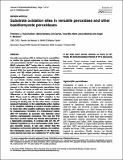Please use this identifier to cite or link to this item:
http://hdl.handle.net/10261/10249Share/Export:
 SHARE SHARE
 CORE
BASE CORE
BASE
|
|
| Visualizar otros formatos: MARC | Dublin Core | RDF | ORE | MODS | METS | DIDL | DATACITE | |

| Title: | Substrate oxidation sites in versatile peroxidase and other basidiomycete peroxidases |
Authors: | Ruiz-Dueñas, F. J. CSIC ORCID ; Morales, María CSIC; García-Ruiz, Eva CSIC ORCID ; Miki, Yuta CSIC; Martínez, María Jesús CSIC ORCID ; Martínez, Ángel T. CSIC ORCID | Keywords: | Crystal structures Fungal peroxidases Haem access-channel Lignin biodegradation Manganese-binding site Site-directed mutagenesis Spectroscopic analyses Transient-state kinetics Tryptophanyl radical Versatile peroxidase |
Issue Date: | 5-Nov-2008 | Publisher: | Oxford University Press | Citation: | Journal of Experimental Botany 60 (2) :441-52 (2009) | Abstract: | Versatile peroxidase (VP) is defined by its capabilities to oxidize the typical substrates of other basidiomycete peroxidases: (i) Mn(2+), the manganese peroxidase (MnP) substrate (Mn(3+) being able to oxidize phenols and initiate lipid peroxidation reactions); (ii) veratryl alcohol (VA), the typical lignin peroxidase (LiP) substrate; and (iii) simple phenols, which are the substrates of Coprinopsis cinerea peroxidase (CIP). Crystallographic, spectroscopic, directed mutagenesis, and kinetic studies showed that these 'hybrid' properties are due to the coexistence in a single protein of different catalytic sites reminiscent of those present in the other basidiomycete peroxidase families. Crystal structures of wild and recombinant VP, and kinetics of mutated variants, revealed certain differences in its Mn-oxidation site compared with MnP. These result in efficient Mn(2+) oxidation in the presence of only two of the three acidic residues forming its binding site. On the other hand, a solvent-exposed tryptophan is the catalytically-active residue in VA oxidation, initiating an electron transfer pathway to haem (two other putative pathways were discarded by mutagenesis). Formation of a tryptophanyl radical after VP activation by peroxide was detected using electron paramagnetic resonance. This was the first time that a protein radical was directly demonstrated in a ligninolytic peroxidase. In contrast with LiP, the VP catalytic tryptophan is not beta-hydroxylated under hydrogen peroxide excess. It was also shown that the tryptophan environment affected catalysis, its modification introducing some LiP properties in VP. Moreover, some phenols and dyes are oxidized by VP at the edge of the main haem access channel, as found in CIP. Finally, the biotechnological interest of VP is discussed. | Description: | 12 pages, 2 figures.-- PMID: 18987391 PubMed | Publisher version (URL): | http://dx.doi.org/10.1093/jxb/ern261 | URI: | http://hdl.handle.net/10261/10249 | DOI: | 10.1093/jxb/ern261 | ISSN: | 0022-0957 |
| Appears in Collections: | (CIB) Artículos |
Files in This Item:
| File | Description | Size | Format | |
|---|---|---|---|---|
| Ruiz-Dueñas_et_al_JXB_2008.pdf | 521,88 kB | Adobe PDF |  View/Open |
CORE Recommender
SCOPUSTM
Citations
219
checked on Apr 20, 2024
WEB OF SCIENCETM
Citations
200
checked on Feb 25, 2024
Page view(s)
578
checked on Apr 24, 2024
Download(s)
548
checked on Apr 24, 2024
Google ScholarTM
Check
Altmetric
Altmetric
WARNING: Items in Digital.CSIC are protected by copyright, with all rights reserved, unless otherwise indicated.
